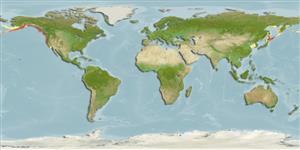Environment: milieu / climate zone / depth range / distribution range
Ökologie
seewasser; brackwasser demersal; standorttreu; tiefenbereich 0 - 102 m (Ref. 58496). Temperate; 66°N - 32°N
North Pacific: Sea of Okhotsk and the Bering Sea to Los Angeles County, USA, but records west of the Gulf of Alaska doubtful.
Size / Gewicht / Alter
Maturity: Lm ? range ? - ? cm
Max length : 8.9 cm TL Männchen/unbestimmt; (Ref. 2850)
Rückenflossenstacheln (insgesamt): 8 - 9; Rückenflossenweichstrahlen (insgesamt): 16-18; Afterflossenstacheln 0; Afterflossenweichstrahlen: 12 - 14. Caudal fin rounded; .
A resident intertidal species with homing behavior (Ref. 32612), found in sheltered areas and common in tide pools (Ref. 2850). In areas with rough surf, it occurs in higher, more sheltered places (Ref. 2850). Can leave tide pools when aquatic conditions become inhospitable (Ref. 31184). Shows a tendency to return to its home pool if displaced (Ref. 6885). Breathes air when out of water (Ref. 31184).
Males clasp females with their pectoral fin and fertilizes the eggs as it is being deposited on a rock (Ref. 6885).
Eschmeyer, W.N., E.S. Herald and H. Hammann, 1983. A field guide to Pacific coast fishes of North America. Boston (MA, USA): Houghton Mifflin Company. xii+336 p. (Ref. 2850)
IUCN Rote Liste Status (Ref. 130435)
Bedrohung für Menschen
Harmless
Nutzung durch Menschen
Fischereien:
Mehr Information
PartnerBilderStamps, Coins Misc.LauteCiguateraGeschwindigkeitSchwimmstilKiemenoberflächeOtolithsGehirngrößeSehfähigkeit
Tools
Zusatzinformationen
Download XML
Internet Quellen
Estimates based on models
Preferred temperature (Ref.
123201): 5.8 - 14, mean 9.1 °C (based on 242 cells).
Phylogenetic diversity index (Ref.
82804): PD
50 = 0.5625 [Uniqueness, from 0.5 = low to 2.0 = high].
Bayesian length-weight: a=0.00676 (0.00300 - 0.01523), b=3.17 (2.98 - 3.36), in cm total length, based on LWR estimates for this (Sub)family-body shape (Ref.
93245).
Trophic level (Ref.
69278): 3.4 ±0.47 se; based on food items.
Generation time: 5.3 ( na - na) years. Estimated as median ln(3)/K based on 1
growth studies.
Widerstandsfähigkeit (Ref.
120179): hoch, Verdopplung der Population dauert weniger als 15 Monate. (K=0.21; tm=1).
Fishing Vulnerability (Ref.
59153): Moderate vulnerability (37 of 100).
